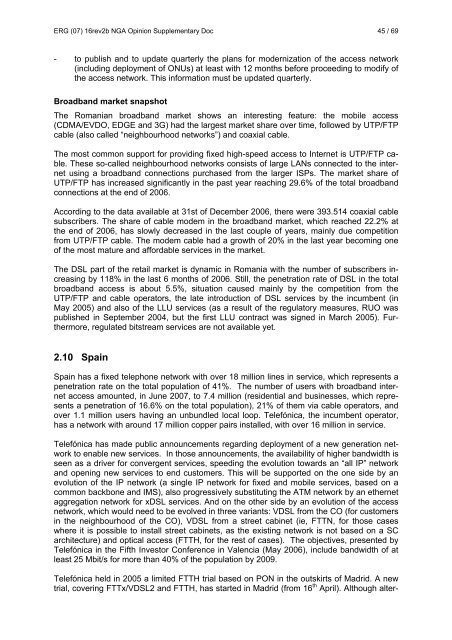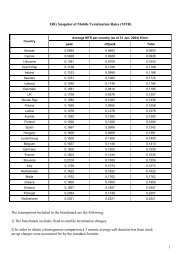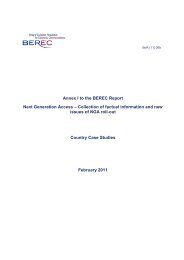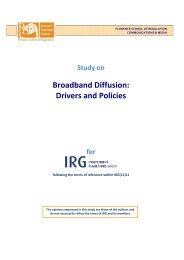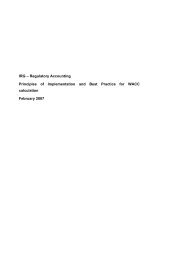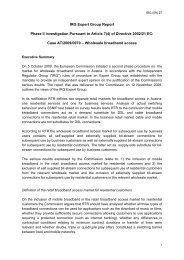16 Rev2b NGA Opinion Supplementary doc - IRG
16 Rev2b NGA Opinion Supplementary doc - IRG
16 Rev2b NGA Opinion Supplementary doc - IRG
Create successful ePaper yourself
Turn your PDF publications into a flip-book with our unique Google optimized e-Paper software.
ERG (07) <strong>16</strong>rev2b <strong>NGA</strong> <strong>Opinion</strong> <strong>Supplementary</strong> Doc 45 / 69<br />
- to publish and to update quarterly the plans for modernization of the access network<br />
(including deployment of ONUs) at least with 12 months before proceeding to modify of<br />
the access network. This information must be updated quarterly.<br />
Broadband market snapshot<br />
The Romanian broadband market shows an interesting feature: the mobile access<br />
(CDMA/EVDO, EDGE and 3G) had the largest market share over time, followed by UTP/FTP<br />
cable (also called “neighbourhood networks”) and coaxial cable.<br />
The most common support for providing fixed high-speed access to Internet is UTP/FTP cable.<br />
These so-called neighbourhood networks consists of large LANs connected to the internet<br />
using a broadband connections purchased from the larger ISPs. The market share of<br />
UTP/FTP has increased significantly in the past year reaching 29.6% of the total broadband<br />
connections at the end of 2006.<br />
According to the data available at 31st of December 2006, there were 393.514 coaxial cable<br />
subscribers. The share of cable modem in the broadband market, which reached 22.2% at<br />
the end of 2006, has slowly decreased in the last couple of years, mainly due competition<br />
from UTP/FTP cable. The modem cable had a growth of 20% in the last year becoming one<br />
of the most mature and affordable services in the market.<br />
The DSL part of the retail market is dynamic in Romania with the number of subscribers increasing<br />
by 118% in the last 6 months of 2006. Still, the penetration rate of DSL in the total<br />
broadband access is about 5.5%, situation caused mainly by the competition from the<br />
UTP/FTP and cable operators, the late introduction of DSL services by the incumbent (in<br />
May 2005) and also of the LLU services (as a result of the regulatory measures, RUO was<br />
published in September 2004, but the first LLU contract was signed in March 2005). Furthermore,<br />
regulated bitstream services are not available yet.<br />
2.10 Spain<br />
Spain has a fixed telephone network with over 18 million lines in service, which represents a<br />
penetration rate on the total population of 41%. The number of users with broadband internet<br />
access amounted, in June 2007, to 7.4 million (residential and businesses, which represents<br />
a penetration of <strong>16</strong>.6% on the total population), 21% of them via cable operators, and<br />
over 1.1 million users having an unbundled local loop. Telefónica, the incumbent operator,<br />
has a network with around 17 million copper pairs installed, with over <strong>16</strong> million in service.<br />
Telefónica has made public announcements regarding deployment of a new generation network<br />
to enable new services. In those announcements, the availability of higher bandwidth is<br />
seen as a driver for convergent services, speeding the evolution towards an “all IP” network<br />
and opening new services to end customers. This will be supported on the one side by an<br />
evolution of the IP network (a single IP network for fixed and mobile services, based on a<br />
common backbone and IMS), also progressively substituting the ATM network by an ethernet<br />
aggregation network for xDSL services. And on the other side by an evolution of the access<br />
network, which would need to be evolved in three variants: VDSL from the CO (for customers<br />
in the neighbourhood of the CO), VDSL from a street cabinet (ie, FTTN, for those cases<br />
where it is possible to install street cabinets, as the existing network is not based on a SC<br />
architecture) and optical access (FTTH, for the rest of cases). The objectives, presented by<br />
Telefónica in the Fifth Investor Conference in Valencia (May 2006), include bandwidth of at<br />
least 25 Mbit/s for more than 40% of the population by 2009.<br />
Telefónica held in 2005 a limited FTTH trial based on PON in the outskirts of Madrid. A new<br />
trial, covering FTTx/VDSL2 and FTTH, has started in Madrid (from <strong>16</strong> th April). Although alter-


